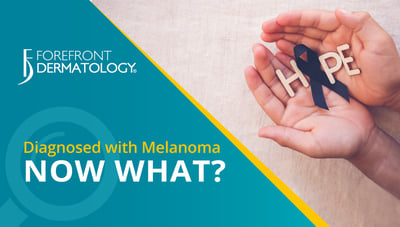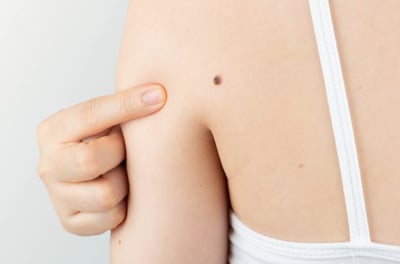
Have you recently been diagnosed with skin cancer and are interested in learning more about treatment options? According to Dr. Rhett Kent, board-certified dermatologist with Forefront Dermatology, “Skin cancer treatment options will vary based on the type of skin cancer you are diagnosed with, along with the extent of your cancer. For example, an early basal cell carcinoma will be treated differently than a late stage melanoma. With that being said, below is a list of the most common skin cancer treatment options. Ultimately, the best treatment is determined on a case by case basis, and the best course of action for your skin cancer will be determined based on detailed conversations with your dermatologist.”
Freezing / Cryosurgery
The most common treatment for actinic keratoses (pre-cancers) is freezing them off with liquid nitrogen and this treatment may also be used on some small, early skin cancers. The extremely cold temperature of the gas leads to ice crystal formation within the cancerous cells that ultimately leads to cell death. The dead tissue sloughs off following treatment and is replaced by normal skin.
Electrodessication & Curettage
Electrodessication & Curettage is a procedure that utilizes a combination of scrapping out the skin cancer and burning the surrounding tissue with an electrosurgical device. Its use is reserved for certain low risk forms of skin cancers. Although no sutures are required, healing generally takes longer than from excisional surgery as the wound is left to heal from the inside out.
Excisional surgery
This type of treatment is the standard option for most types of skin cancer. Your dermatologist will surgically remove the cancerous tissue and a predetermined surrounding margin of healthy skin. This procedure requires wound care and sutures that will need to be removed at a later date.
Mohs micrographic surgery
This procedure is for larger, recurring, difficult-to-treat skin cancers, or for skin cancers is cosmetically sensitive locations. The procedure is a highly-specialized form of skin cancer surgery that involves a tissue conserving technique and same day processing of pathology. This allows the surgeon to conserve as much skin as possible, and to confirm the clearance of cancerous cells at the time of surgery.
Chemotherapy
Chemotherapy is the use of medications to kill cancer cells. For cancers limited to the top layer of skin, creams or lotions containing anti-cancer agents may be applied directly to the skin. Commonly utilized topical chemotherapies include 5-fluorouracil, and ingenol mebutate. Systemic chemotherapy can be used to treat skin cancers that have spread to other parts of the body.
Immunotherapy
These medications harness your body’s immune system to kill cancer cells. Imiquimod is a commonly utilized topical immunotherapy. Systemic immunotherapy has established itself in recent years as the predominant method to treat metastatic melanoma.
Photodynamic therapy
This procedure is an example of field therapy, where the treatment is applied to an entire area affected by multiple cancers and/or pre-cancerous changes. This treatment destroys skin cancer cells by applying a topical, light-activated chemotherapy followed by exposure to the activating wavelength of light.
Radiation therapy
Radiation therapy uses high-powered energy beams, such as X-rays, to kill cancer cells. Radiation therapy may be an option based on the expertise of your dermatologist or when cancer can’t be completely removed by surgery.
Laser therapy
Some lasers can be used for pre-cancerous lesions but are not a traditional treatment modality for true skin cancers. As evidence is accumulating supporting their effectiveness, they may serve a bigger role in the future.
“Again, determining the best treatment for your skin cancer requires an open conversation with your dermatologist. Make sure to ask questions so that you understand your options and why a given treatment is being recommended for you.” noted Dr. Kent.
Be Proactive
Remember, early detection saves lives and a simple, yearly in-office skin screening with your local board-certified Forefront Dermatologist can truly mean the difference between life and death. Find a dermatologist near you today.





